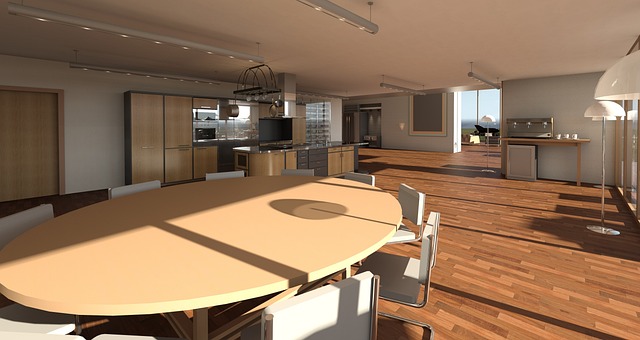3D terrain modeling is a transformative technology for architects, offering detailed digital representations of landforms that enhance design capabilities. By employing techniques like laser scanning and LiDAR, architects can create precise 3D models of complex landscapes, facilitating informed design choices and virtual navigation. This game-changing approach enables visualization of structures in context, streamlining processes from urban planning to environmental impact assessments, ultimately promoting sustainable and aesthetically pleasing built environments through advanced 3D modeling for architects.
In the realm of architecture, precise topographical representation is paramount for informed decision-making. Traditional 2D mapping falls short in conveying complex terrain nuances. Enter 3D terrain modeling—a revolutionary game-changer that offers architects an unparalleled view of landscapes. This article explores the significance of topographical representation, delves into the advent of 3D modeling, and highlights techniques, tools, and benefits that empower architects with accurate data for design, planning, and construction. Discover how 3D modeling for architects is transforming the way we perceive and utilize terrain.
Understanding Topographical Representation and Its Significance in Architecture
Topographical representation is a critical aspect of architecture, offering a detailed visual description of landforms and terrain. It involves accurately depicting the shape, elevation, and features of the Earth’s surface, providing architects with essential insights into the natural landscape. In the realm of 3D modeling for architects, this concept takes on new dimensions. By utilizing 3D terrain modeling techniques, architects can create immersive digital landscapes that mirror the real world.
This technology enables them to visualize and analyze complex topography, aiding in informed design decisions. For instance, understanding the slope and contours of a site is crucial for structural integrity and sustainable design. With 3D models, architects can navigate through virtual landscapes, ensuring their designs are not just aesthetically pleasing but also functionally sound, especially when dealing with challenging terrain.
The Rise of 3D Modeling: A Game-Changer for Topographical Mapping
In recent years, the field of topographical mapping has undergone a significant transformation with the advent of 3D modeling techniques. This innovative approach has revolutionized how we perceive and understand landscapes, offering architects and urban planners an unprecedented level of detail and accuracy. The rise of 3D terrain modeling presents a game-changer in various applications, from architectural design to environmental studies.
By creating digital representations of the Earth’s surface, 3D modeling for architects allows them to visualize and analyze complex topographies with ease. This technology provides a comprehensive view of elevation, slopes, and landforms, enabling designers to make informed decisions during the conceptualization phase. With 3D terrain models, architects can explore various design options, assess potential challenges, and create more sustainable and contextually sensitive buildings that harmonize with their surrounding environments.
Techniques and Tools for Creating Accurate 3D Terrain Models
Creating accurate 3D terrain models involves a blend of advanced techniques and specialized tools designed to capture Earth’s complex landscapes digitally. Architects, in particular, benefit from this technology as it allows them to visualize and interact with topographical data in unprecedented ways. For instance, laser scanning and LiDAR (Light Detection and Ranging) are powerful methods that use light pulses to measure distances and create highly detailed point clouds representing the terrain surface. These point clouds can then be processed using specialized software to generate seamless 3D models.
Additionally, photogrammetry is another valuable technique where multiple photographs of a landscape are merged to produce a 3D model. This process leverages the power of computer vision algorithms to extract geometric information from images, filling in details and textures that might otherwise be challenging to capture. Together with parametric modeling software, architects can now create intricate 3D terrain models that accurately represent real-world locations, enhancing their design capabilities and decision-making processes.
Benefits and Applications: Enhancing Design, Planning, and Construction with 3D Terrain Modeling
3D terrain modeling offers significant advantages for architects and design professionals, revolutionizing how they approach complex projects. By creating detailed digital representations of landscapes, this technology enables a deeper understanding of site characteristics. Architects can now visualize not just structures but also the intricate interplay between buildings and their surroundings, enhancing every aspect of design.
The applications of 3D terrain modeling are vast. It aids in urban planning by accurately simulating cityscapes, helping to identify potential issues before construction begins. In infrastructure development, it facilitates precise planning for roads, bridges, and utilities, ensuring projects align with the natural terrain. Moreover, environmental impact assessments benefit greatly, allowing architects to consider ecological factors from an elevated perspective. This innovative tool not only streamlines design processes but also fosters more sustainable and harmonious built environments.
3D terrain modeling has emerged as a powerful tool for architects, revolutionizing the way we represent and interact with our built environment. By accurately capturing complex topographical features, this technology enables designers to make informed decisions, enhance planning processes, and streamline construction. With advanced techniques and user-friendly tools readily available, 3D modeling for topographical representation is no longer a luxury but an essential asset for modern architects, fostering more efficient and innovative design practices.
